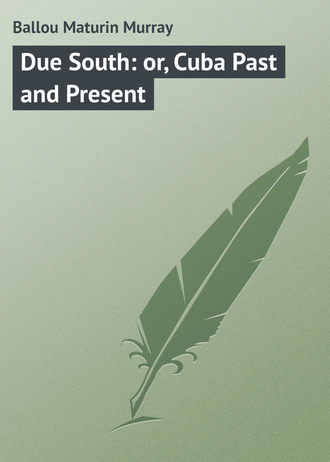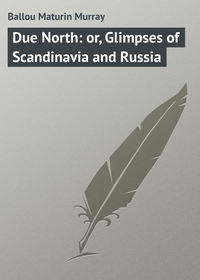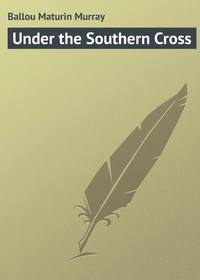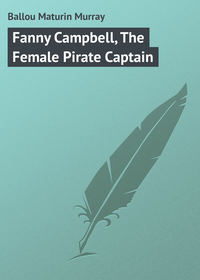 полная версия
полная версияDue South: or, Cuba Past and Present
There are said to be six hundred of the Bahama islands, large and small, of which Nassau is the capital, and there, as already intimated, the English Governor-General resides. This numerical calculation is undoubtedly correct; many are mere rocky islets, and not more than twenty have fixed inhabitants. Is there anything more wonderful in nature than that these hundreds of isles should have been built up from the bottom of the sea by insects so small as to be microscopic? All lie north of Cuba and St. Domingo, just opposite the Gulf of Mexico, easily accessible from our own shores by a short and pleasant sea-voyage of three or four days. They are especially inviting to those persons who have occasion to avoid the rigor of Northern winters. People threatened with consumption seek Nassau on sanitary principles, and yet it was found upon inquiry that many natives die of that insidious disease, which rapidly runs its career when it is first developed in a tropical climate. To the author it would seem that consumptives might find resorts better adapted to the recovery of their health. Intermittent fever, also, is not unknown at Nassau.
The sea gardens, as they are called, situated just off the shores of the island, are well worth a visit; where, by means of a simple instrument of wood and glass, one is enabled to look many fathoms below the surface of the water, which is here so remarkable for its transparency. These water glasses are all of home manufacture, easily improvised, being formed of a small wooden box three or four inches square, open at the top, and having a water-tight glass bottom. With the glass portion slightly submerged, one is enabled to see distinctly the beautiful coral reefs, with their marvelous surroundings. There are displayed tiny caves and grottoes of white coral of great delicacy and variety, star-fishes, sea-urchins, growing sponges, sea-fans, and gaudy-colored tropical fishes, including the humming-bird-fish, and others like butterflies with mottled fins and scales, and that little oddity the rainbow-fish. The prevailing color of this attractive creature is dark green, but the tinted margins of its scales so reflect the light as to show all the colors of the rainbow, and hence its name. When bottled in alcohol, these fairy-like denizens of the deep lose their brilliancy, which they exhibit only in their native element. This unique display is greatly enhanced in beauty by the clearness of the Bahama waters, and the reflected light from the snow-white sandy bottom, dotted here and there by curious and delicate shells of opalescent lustre. One longs to descend among these coral bowers, – these mermaid-gardens, – and pluck of the submarine flora in its purple, yellow, and scarlet freshness.
It will be remembered that Columbus wrote home to his royal patrons that the fish which abounded in the seas partook of the same novelty which characterized everything else in the New World. This was about four hundred years ago, before the great Genoese had discovered Cuba. "The fish," as he wrote, "rivaled the birds in tropical brilliancy of color, the scales of some of them glancing back the rays of light like precious stones, as they sported about the ships and flashed gleams of gold and silver through the clear water."
The surface life of these translucent waters is also extremely interesting. Here the floating jelly-fish, called, from its phosphorescence, the glow-worm of the sea, is observed in great variety, sheltering little colonies of young fishes within its tentacles, which rush forth for a moment to capture some passing mite, and as quickly return again to their shelter. One takes up a handful of the floating gulf-weed and finds, within the pale yellow leaves and berries, tiny pipe-fish, sea-horses, and the little nest-building antennarius, thus forming a buoyant home for parasites, crabs, and mollusks, itself a sort of mistletoe of the ocean. The young of the mackerel and the herring glance all about just beneath the surface near the shore, like myriad pieces of silver. Now and again that particolored formation of marine life, the Portuguese man-of-war, is observed, its long ventral fins spread out like human fingers to steady it upon the surface of the water. Verily, the German scientist who says there is more of animal life beneath the surface of the sea than above it cannot be far amiss. This seems to be the more reasonable when we consider the relative proportions of land and water. The whole surface of the globe is supposed to have an area of about two hundred million square miles. Of these only about fifty millions are dry land. Within the harbor of Nassau the divisions of shoal and deep water presented most singular and clearly defined lines of color, azure, purple, and orange-leaf green, – so marked as to be visible half a mile away. All was beneath a sky so deeply and serenely blue as constantly to recall the arching heavens of middle India.
The Bahama Banks is a familiar expression to most of us, but perhaps few clearly understand the significance of the term, which is applied to a remarkable plateau at the western extremity of the archipelago, occupying a space between two and three hundred miles long, and about one third as wide. These banks, as they are called, rise almost perpendicularly from an unfathomable depth of water, and are of coral formation. In sailing over them the bottom is distinctly seen from the ship's deck, the depth of water being almost uniformly forty to fifty feet. Some years since, when the author was crossing these banks in a sailing ship, a death occurred among the foremast hands, and the usual sea burial followed. The corpse was sewn up in a hammock, with iron weights at the feet, the more readily to sink it. After reading the burial service the body was launched into the sea from a grating rigged out of a gangway amidship. The waters were perfectly calm, and the barque had but little headway. Indeed, we lay almost as still as though anchored, so that the body was seen to descend slowly alongside until it reached the calcareous, sandy bottom, where it assumed an upright and strangely lifelike position, as though standing upon its feet. An ominous silence reigned among the watching crew, and it was a decided relief to all hands when a northerly wind sprang up, filling the canvas and giving the vessel steerage way.
So many years have passed since the occurrence of the scene just related that we may give its sequel without impropriety, though, at the same time, we expose the venal character of Spanish officials. The man we buried on the Bahama Banks had died of small-pox, though no other person on board showed any symptoms of the disease. On entering the harbor of Havana, three days later, we had been hailed from Moro Castle and had returned the usual answer. A couple of doubloons in gold made the boarding officer conveniently blind, and a similar fee thrust quietly into the doctor's hand insured a "clean bill of health," under which we were permitted to land! The alternative was twenty-one days' quarantine.
Fort Montague, mounting four rusty guns, "with ne'er a touch-hole to any on 'em," as Bushy informed us, stands upon a projecting point about a mile from the town of Nassau, the road thither forming a delightful evening promenade, or drive. The fort is old, crumbling, and time-worn, but was once occupied by the buccaneers as a most important stronghold commanding the narrow channel. These sea-robbers imposed a heavy tax upon all shipping passing this way, and for many years realized a large income from this source. It was only piracy in another form. Most vessels found it cheaper to pay than to fight. When the notorious Black Beard had his headquarters at Nassau, he sought no such pretext, but preyed upon all commerce alike, provided the vessels were not too well armed to be captured. This notorious pirate had an innate love for cruelty, and often tortured his captives without any apparent purpose, after the fashion of our Western Indians. When the English lashed the mutineers of Delhi and Cawnpore to the muzzles of their cannon and blew them to pieces, they were enacting no new tragedy; legend and history tell us that Black Beard, the pirate of the Windward Passage, set them that example many years before. His rule was to murder all prisoners who would not join his ship, and those whom he took fighting, that is, with arms in their hands, were subjected to torture, one form of which was that of lashing captives to the cannon's mouth and applying the match. Fort Montague is not occupied by even a corporal's guard to-day, and is of no efficiency whatever against modern gunnery. The reader will thus observe that the principal business which has engaged Nassau heretofore has been wrecking, buccaneering, privateering, and blockade running.
Some noted characters have found an asylum here, first and last. After Lord Dunmore left Virginia he sought official position and made a home on the island. He was appointed governor, and some of the buildings erected by him are still pointed out to the visitor, especially that known as the Old Fort, just back of the Victoria Hotel, crowning the height. His summer seat, known as the Hermitage, is a quaint old place, still in fair condition, and surrounded by oaks and cocoanut trees, near the sea. Such matters do not often get into history, but legend tells us that some strange orgies took place at the Hermitage, where the play was for heavy stakes, and the drinking was of a similar excessive character.
Another well-known individual who sought to make a home here, and also to escape from all former associations, was the notorious Blennerhasset, a name familiar in connection with Aaron Burr. After his trial, it will be remembered that he suddenly disappeared, and was heard of no more. He left his country for his country's good, changing his name to that of Carr. His objective point was Nassau; there his undoubted talent and legal ability were duly recognized and he was appointed government attorney, officiating in that capacity for a number of years. Having deserted his first wife, he found another to console him upon the island. At last wife number one appeared upon the island. She had discovered his hiding-place, and a domestic war ensued. Wife number two carried the day and the rightful spouse was sent away and paid an annuity to keep away. The pretended Mr. Carr is said to have finally lapsed into habits of excessive intemperance, and to have found a stranger's grave on the island.
Much of the drinking water, and certainly the best in use at Nassau, as well as on some of the neighboring islands, is procured in a remarkable, though very simple manner, from the sea. Not far from shore, on the coral reefs, there are never-failing fresh water springs, bubbling up from the bottom through the salt water with such force as clearly to indicate their locality. Over these ocean springs the people place sunken barrels filled with sand, one above another, the bottoms and tops being displaced. The fresh water is thus conducted to the surface through the column of sand, which forms a perfect filterer. Such a crude arrangement is only temporary, liable to be displaced by any severe storm which should agitate the surrounding waters. If destroyed in the hurricane season, these structures are not renewed until settled weather. In so small and low lying an island as that of Nassau, it is very plain that this crystal liquid, pure and tasteless, cannot come from any rainfall upon the soil, and its existence, therefore, suggests a problem, the solving of which we submit to the scientists.
On the arid shores of the Persian Gulf, where rain so seldom falls, and where there are no rills to refresh the parched soil, fresh water is also obtained from submerged springs beneath the salt water. Here it is brought to the surface by divers, who descend with a leather bag, the mouth of which being opened over the bubbling spring is quickly filled and closed again, being drawn to the surface by those who are left there to assist the diver, who hastens upward for air. In descending his feet are weighted with stones, which being cast off at the proper moment, he naturally rises at once to the surface. This operation is repeated until a sufficient quantity of fresh water is procured. There is no mystery, however, as to the source of these springs. The rain first falls on the distant mountains, and finding its way downward through the fissures of rocky ledges, pursues its course until it gushes forth in the bed of the gulf.
CHAPTER II
Among the Islands. – San Salvador. – A Glimpse at the Stars. – Hayti. – The Gulf Stream. – The Caribbean Sea. – Latitude and Longitude. – The Southern Coast of Cuba. – A Famous Old Fortress. – Fate of Political Prisoners. – The Oldest City in Cuba. – The Aborigines. – Cuban Cathedrals. – Drinking Saloons. – Dogs, Horses, and Coolies. – Scenes in Santiago de Cuba. – Devoured by Sharks. – Lying at Anchor. – Wreck of a Historic Ship. – Cuban Circulating Medium. – Tropical Temperature.
After leaving Nassau we stood northward for half a day in order to get a safe and proper channel out of the crooked Bahamas, where there is more of shoal than of navigable waters, leaving a score of small islands behind us inhabited only by turtles, flamingoes, and sea birds. But we were soon steaming due south again towards our objective point, the island of Cuba, five hundred miles away. San Salvador was sighted on our starboard bow, the spot where Columbus first landed in the New World, though even this fact has not escaped the specious arguments of the iconoclasts. Nevertheless, we gazed upon it with reverent credulity. It will be found laid down on most English maps as Cat Island, and is now the home of two or three thousand colored people. San Salvador is nearly as large as New Providence, and is said to claim some special advantages over that island in the quality of its fruits. It is claimed that the oranges grown here are the sweetest and best in the world, the same excellence being attributed to its abundant yield of pineapples and other tropical fruits.
There are so many of these small islands in the Bahama group that the geographers may be excused for the heterogeneous manner in which they have placed them on the common maps. To find their true and relative position one must consult the sailing-charts, where absolute correctness is supposed to be found, a prime necessity in such intricate navigation. The total population of the Bahamas has been ascertained, by census, to be a fraction less than forty thousand.
The voyager in these latitudes is constantly saluted by gentle breezes impregnated with tropical fragrance, intensified in effect by the distant view of cocoanut, palmetto, and banana trees, clothing the islands and growing down to the water's very edge. As we glide along, gazing shoreward, now and again little groups of swallows seem to be flitting only a few feet above the water for a considerable distance, and then suddenly disappearing beneath the waves. These are flying-fish enjoying an air bath, either in frolic or in fear; pursued, may be, by some aqueous enemy, to escape from whom they essay these aerial flights. The numerous islands, very many of which are uninhabited, have yet their recorded names, more or less characteristic, such as Rum Key, Turk's Island, – famous for the export of salt, – Bird Rock, Fortune Island, Great and Little Inagua, Crooked Island, and so on, all more or less noted for the disastrous wrecks which have occurred on their low coralline shores. Our Northern cities are largely dependent upon the Bahamas for their early annual supplies of pineapples, cocoanuts, oranges, bananas, and some vegetables, in which they are all more or less prolific. Here also is the harvest field of the conchologist, the beaches and coral reefs affording an abundant supply of exquisitely colored shells, of all imaginable shapes, including the large and valuable conch-shell, of which many thousand dollars' worth are annually exported, the contents first serving the divers for food.
It was interesting to remain on deck at night and watch the heavens, as we glided silently through the phosphorescent sea. Was it possible the grand luminary, which rendered objects so plain that one could almost read fine print with no other help, shone solely by borrowed light? We all know it to be so, and also that Venus, Mars, Jupiter, and Saturn shine in a similar manner with light reflected from the sun. It was curious to adjust the telescope and bring the starry system nearer to the vision. If we direct our gaze upon a planet we find its disk sharply defined; change the direction and let it rest upon a star, and we have only a point of light, more or less brilliant. The glass reveals to us the fact that the star-dust which we call the Milky Way is an aggregation of innumerable single suns. Sweeping the arching blue with the telescope, we find some stars are golden, some green, others purple, many silvery-white, and some are twins. Probably there is no such thing as stars of the first and second magnitude, as the common expression names them. It is most likely only a question of distance, which regulates the brightness to our vision. Science reduces the distances of heavenly bodies from our earth to figures, but they are so immense as to be simply bewildering. At the North the moon is silvery, but in tropical skies at night it becomes golden, glowing, and luxurious in its splendor, never pale and wan as it seems with us.
When the lonely lighthouse which marks Cape Maysi, at the easterly point of Cuba, hove in sight on the starboard bow, the dim form of the mountains of Hayti was also visible on the opposite horizon. A subterranean connection is believed to exist between the mountain ranges of the two islands.
When the outline of the Haytian mountains was in view, it was very natural to express a wish to visit the island at some convenient time. This led to some intelligent and interesting remarks from a compagnon de voyage, who had resided for two years at Port-au-Prince, the capital. "Unless you are compelled to land there," said he, "I advise you to avoid Hayti." He fully confirmed the reports of its barbarous condition, and declared it to be in a rapid decadence, as regarded every desirable element of civilization. In the country, a short distance from either Gonaives, Jacmel, or Port-au-Prince, where the mass of the negro population live, Voudou worship and cannibalism are quite common at the present time. The influence of the Voudou priests is so much feared by the government that the horrible practice is little interfered with. When the officials are forced to take cognizance of the crime, the lightest possible punishment is imposed upon the convicted parties. The island of San Domingo is about half the size of Cuba, Hayti occupying one third of the western portion, the rest of the territory belonging to the republic of San Domingo. "As to Port-au-Prince," said our informant, "it is the dirtiest place I have ever seen in any part of the world." Nevertheless, the historic interest clustering about the island is very great. It was the seat of the first Spanish colony founded in the New World. Its soil has been bathed in the blood of Europeans as well as of its aboriginal inhabitants. For three hundred years it was the arena of fierce struggles between the French, Spaniards, and English, passing alternately under the dominion of each of these powers, until finally, torn by insurrection and civil war, in 1804 it achieved its independence. The city of San Domingo, capital of the republic, is the oldest existing settlement by white men in the New World, having been founded in 1494 by Bartholomew Columbus. It contains to-day a little less than seven thousand inhabitants.
We gave Cape Maysi a wide berth, as a dangerous reef makes out from the land, eastward, for a mile or more. The fixed light at this point is a hundred and thirty feet above sea level, and is visible nearly twenty miles off shore.
We were running through the Windward Passage, as it was called by the early navigators, and whence one branch of the Gulf Stream finds its way northward. The Gulf Stream! Who can explain the mystery of its motive power; what keeps its tepid waters in a course of thousands of miles from mingling with the rest of the sea; whence does it come? The accepted theories are familiar enough, but we do not believe them. Maury says the Gulf of Mexico is its fountain, and its mouth is the Arctic Sea. The maps make the eastern shore of Cuba terminate as sharply as a needle's point, but it proved to be very blunt in reality, as it forms the gateway to the Caribbean Sea, where the irregular coast line runs due north and south for the distance of many leagues. It is a low, rocky shore for the most part, but rises gradually as it recedes inland, until it assumes the form of hills so lofty as to merit the designation of mountains.
There was on board of our ship an intelligent resident of Santiago, who was enthusiastic in his description of the plains and valleys lying beyond the hills which stood so prominently on the coast, – hills probably older than any tongue in which we could describe them. The Scriptural Garden of Eden has absolutely been placed here by supposition on the part of traveled people. The temperature is simply perfect, if we are to believe our informant; the vegetation is of a primitive delicacy and beauty unequaled elsewhere; the fruits are fabulously abundant and of the most perfect flavor; the water bubbles forth from springs of crystal purity, and the flora is so lovely as to inspire the most indifferent beholder with delight. "It is called the Garden of Cuba," said the American Consul of Cienfuegos, "but many go further, and declare it to be the location of the original Paradise." Certain it is that the few Americans who have sought this so highly praised region, though compelled to deny themselves the ordinary comforts to be found in more accessible resorts, have admitted with emphasis that nature, pure and undefiled, was here to be enjoyed in unstinted measure.
The hills bordering the shore and extending some distance inland contain much undeveloped mineral wealth, such as iron, silver, and gold. A mine of the former product is now being profitably worked by an American company, and the ore regularly shipped to Pennsylvania for smelting. This ore has special properties which render it more than usually valuable, and it is even claimed to be the best iron mine in the world. There is a strangely solitary and inhospitable appearance about this portion of the island, devoid as it is of all human habitations, and fringed either with long reaches of lonely snow-white beach or rugged brown rocks. The volcanic appearance of the land is significant of former upheavals, and this immediate region is still occasionally troubled with geological chills and fever.
The nights of early March in this latitude were exceedingly beautiful, and solemnly impressive was the liberal splendor of the sky. The full moon looked down upon and was reflected by waters of perfect smoothness. River navigation could not have been more quiet than were these nights on the blue Caribbean Sea. The air was as mild as June in New England, while at night the Southern Cross and the North Star blazed in the horizon at the same time. As we steered westward after doubling the cape, both of these heavenly sentinels were seen abeam, the constellation on our port side, and the North Star on the starboard. Each day, at the noon hour, the passengers were interested in watching the officers of the ship while they were "taking the sun," to determine the latitude and longitude. Shall we put the process into simple form for the information of the uninitiated? When the sun reaches the meridian, or culminating point of ascension, the exact moment is indicated by the instrument known as a quadrant, adjusted to the eye of the observer. The figures marked on the quadrant give the latitude of the ship at the moment of meridian. The ship's time is then made to correspond, that is to say, it must indicate 12 o'clock, M., after which it is compared with the chronometer's Greenwich time, and the difference enables the observer to determine the longitude. As fifteen miles are allowed to the minute, there will be nine hundred miles to the hour. The importance of absolute correctness in the chronometer will at once be realized, since, were it only three minutes out of the way, it would render the calculation as to longitude wrong by nearly fifty miles, which might be, and doubtless often has been, the cause of wrecking a ship upon rocks laid down upon the charts, but supposed to be far away. With the chronometer and the quadrant observation correctly ascertained, the sailing-master can prick off his exact situation on the chart. So long as the weather will permit a clear view of the sun at noon, the ship's precise location on the wide waste of waters can be known; but when continuous cloudy weather prevails, the ship's course is calculated by what is called dead reckoning, depending upon the speed and distance run as indicated by the log, which is cast hourly under such circumstances, and becomes the main factor in calculating the position of the ship. Of course the result cannot be very accurate, but is a dernier ressort. When land is in sight no observation is necessary, as the bearing of the ship is then unmistakably defined.









